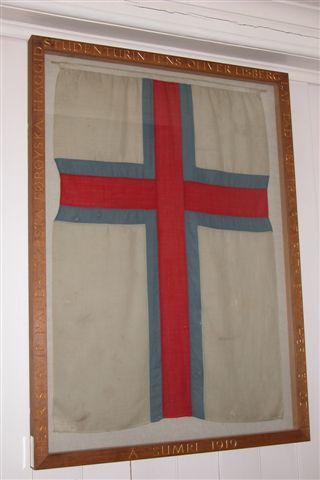The flag of the Faroe Islands (in Faroese: Merkið [ˈmɛʃtʃɪ]) is an offset cross, representing Christianity. It is similar in design to other Nordic flags – a tradition set by the Dannebrog of Denmark,[1][2] of which the Faroe Islands are an autonomous territory.[3]
 | |
| Merkið | |
| Use | National flag and civil ensign |
|---|---|
| Proportion | 8:11 |
| Adopted | 25 April 1940 |
| Design | A blue-fimbriated red Nordic cross on a white field |
| Designed by | Jens Oliver Lisberg |


The flag is called Merkið, which means "the banner" or "the mark". It resembles the flags of neighbouring Norway and Iceland.
Description and symbolism
editThe design of the flag incorporates a red Nordic cross, which is offset to the left. The red cross is fimbriated azure and is set on a white field. The flag design closely resembles that of the Norwegian flag, with the fimbriated cross and the same proportions, 6-1-2-1-6 and 6-1-2-1-12.
White symbolises the foam of the sea and the pure, radiant sky of the Faroe Islands, while the old Faroese blue and red colours are reminiscent of other Scandinavian and Nordic flags, representing the Faroe Islands' bonds with other Nordic countries.[4]
Colours
editThe specific colours of the flag are defined in a 1959 law.[5]
| Scheme | White | Red[6] | Blue[7] |
|---|---|---|---|
| Pantone | Safe | PMS 032 | PMS 300 |
| RGB | #FFFFFF | #EF303E | #005EB9 |
History
editThe modern Faroese flag was devised in 1919 by Jens Oliver Lisberg and others while they were studying in Copenhagen. The first time Merkið was raised in the Faroe Islands was on 22 June that year in Fámjin on the occasion of a wedding. On 25 April 1940, the British occupation government approved the flag for use by Faroese vessels, during the tenure of Carl Aage Hilbert as Danish prefect. Britain did not want the same flag as German-occupied Denmark to be used. April 25 is still celebrated as Flaggdagur and it is a national holiday. With the Home Rule Act of 23 March, 1948, the flag was recognized by the Danish Government as the national flag of the Faroes. The original flag is displayed in the church of Fámjin in Suðuroy.
-
The flag of the Union of Kalmar, of which the Faroes were part.
-
The flag of Denmark, was used before the Faroese flag became official.
-
The old flag.[when?]
See also
editNotes
edit- ^ Andrew Evans (2008). Iceland. Bradt. ISBN 9781841622156. Retrieved 2007-12-31.
Legend states that a red cloth with the white cross simply fell from the sky in the middle of the 13th-century Battle of Valdemar, after which the Danes were victorious. As a badge of divine right, Denmark flew its cross in the other Scandinavian countries it ruled and as each nation gained independence, they incorporated the Christian symbol.
- ^ The Australian Flag: Colonial Relic or Contemporary Icon. William Gaunt & Sons. 2010. ISBN 978-9004181489. Retrieved 2007-12-31.
The Christian cross, for instance, is one of the oldest and most widely used symbols in the world, and many European countries, such as the United Kingdom, Norway, Sweden, Finland, Denmark, Iceland, Greece and Switzerland, adopted and currently retain the Christian cross on their national flags.
- ^ * Benedikter, Thomas (2006-06-19). "The working autonomies in Europe". Society for Threatened Peoples. Archived from the original on 2008-03-09. Retrieved 2019-08-30.
Denmark has established very specific territorial autonomies with its two island territories
- Ackrén, Maria (November 2017). "Greenland". Autonomy Arrangements in the World. Archived from the original on 2019-08-30. Retrieved 2019-08-30.
Faroese and Greenlandic are seen as official regional languages in the self-governing territories belonging to Denmark.
- "Facts about the Faroe Islands". Nordic cooperation. Archived from the original on 23 April 2018. Retrieved 1 July 2015.
The Faroe Islands […] is one of three autonomous territories in the Nordic Region
- Ackrén, Maria (November 2017). "Greenland". Autonomy Arrangements in the World. Archived from the original on 2019-08-30. Retrieved 2019-08-30.
- ^ Smith/Neubecker: Wappen und Flaggen aller Nationen. München 1981; ISBN 3-87045-183-1
- ^ "Løgtingslóg no. 42 frá 17. juli 1959 um flaggið, sum broytt við løgtingslóg nr. 109 frá 29. desember 1998". logir.fo (in Faroese). 17 July 1959. Retrieved 30 March 2021.
- ^ PANTONE. "PANTONE Red 032 C - find a PANTONE Color". www.pantone.com. Archived from the original on 2023-03-21. Retrieved 2021-03-29.
- ^ PANTONE. "PANTONE 300 C - find a PANTONE Color". www.pantone.com. Archived from the original on 2023-03-21. Retrieved 2021-03-29.
References
edit- Faroe Islands at Flags of the World
- Learn about the Flag of Faroe islands on Faroeisland.fo